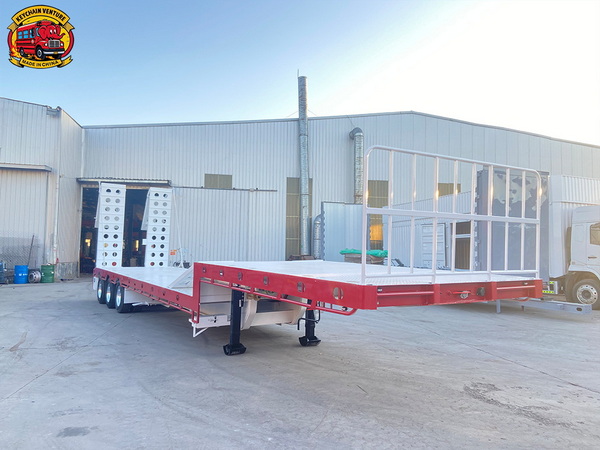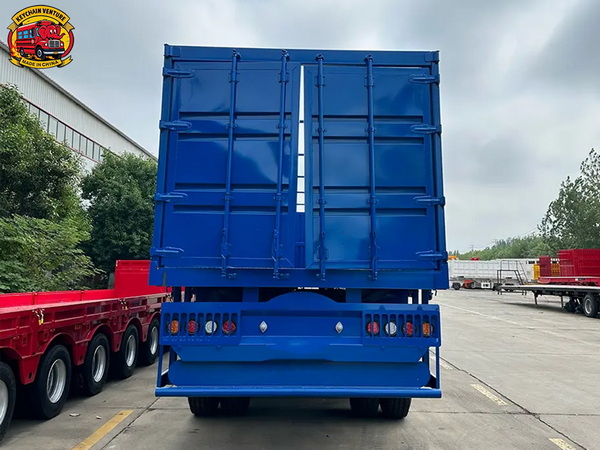Views: 222 Author: Amanda Publish Time: 2025-10-28 Origin: Site








Content Menu
● Standard Lengths of Semi Trailers
>> Europe
>> Australia
● Factors Determining Semi Trailer Length
● Key Dimensions Beyond Length
● Types of Semi Trailers and Their Lengths
>> Refrigerated (Reefer) Trailers
● Impacts of Trailer Length Choices
● Regulatory Perspectives: How Laws Shape Trailer Length
● Technological Trends and Innovations
● Best Practices for Fleet Operators
● Challenges and Opportunities with Semi Trailer Length
>> Challenges
● Future Trends in Semi Trailer Length
● Frequently Asked Questions (FAQ)
>> 1. What is the standard length of a semi trailer in the United States?
>> 2. How does European regulation differ regarding semi trailer lengths?
>> 3. Why are standardized lengths so important in logistics?
>> 4. Are there exceptions to standard semi trailer lengths?
>> 5. What should a company prioritize when choosing semi trailer length?
The semi trailer stands as the cornerstone of the modern transportation and logistics industry, driving the flow of goods across cities, continents, and international borders. For logistics professionals, commercial vehicle suppliers, and freight operators, understanding the normal length of a semi trailer is about more than compliance—it's about maximizing efficiency, safely navigating highways, and ensuring cost-effective operations.
This comprehensive guide explores semi trailer length standards in major global regions, regulatory factors, commercial implications, types of trailers, and practical considerations for buyers and operators. By the end, readers will grasp the operational impact of trailer length, making informed choices that elevate their business.

A semi trailer is a type of large freight-carrying trailer designed without a front axle. Instead, the front is supported by a tractor unit (the powered vehicle), forming an articulated combination commonly called a "tractor-trailer" or an "18-wheeler" in the United States. This design enables excellent maneuverability, increased cargo capacity, and quick loading/unloading, making the semi trailer a fundamental component in road-based logistics.
In the US, the 53-foot semi trailer is the standard among most trucking fleets today. Some older vehicles or those used in city deliveries may feature 48-foot trailers, but the industry's shift toward 53 feet is driven by cargo optimization and evolving federal regulations. This length refers to the internal cargo space, maximizing available volume for both palletized goods and bulk freight.
The standard for European semi trailers is generally 13.6 meters (approximately 44.6 feet). European Community (EC) laws strictly define these dimensions, ensuring consistency for international commerce throughout the continent. Exceptions exist, such as extended trailers for specific applications, but 13.6 meters remains the core standard.
Asian markets, specifically China, commonly use semi trailers between 12 and 13.6 meters (39–44.6 feet) in length. This aligns with both containerized shipping standards and local regulatory frameworks, which are designed for seamless intermodal transfers with global shipping.
Australia's semi trailers generally span 45 to 53 feet, depending on purpose and region. In the vast outback, “road trains” can be much longer, but most commercial fleets operate within the same length ranges as the US and Europe to maintain compatibility and compliance.
Numerous factors drive the selection and regulation of semi trailer length globally:
- Legal and Safety Regulations: Authorities set upper limits to reduce environmental impact, prevent road damage, and ensure safety.
- Cargo Requirements: Palletized, oversized, or specialty cargo may need non-standard lengths for optimal fit.
- Infrastructure: Urban deliveries or narrow routes might benefit from shorter trailers for better navigation.
- Loading and Operational Efficiency: The right length can streamline dock work and cargo stacking while maximizing cubic space.
- International Trade Compatibility: Standard lengths facilitate easier transfers between road, rail, and marine shipping.
While length is critical, width and height are also standardized for safety and efficiency.
- Width: US and European regulations generally set width at 102 inches (8.5 feet) and 2.55 meters, respectively.
- Height: Trailers are typically 13.5 to 14 feet tall in the US. European and Asian regulations set heights up to 4 meters.
Ensuring these standards enables consistent clearances, safer highway merging, and efficient warehouse design around known vehicle dimensions.
The most common type found in logistics, the dry van is a fully enclosed trailer intended for general cargo. In the US, the norm is 53 feet; in Europe, 13.6 meters.
Refrigerated trailers maintain the same general dimensions as dry vans, with added insulation and cooling units. Length standards ensure compatibility with cold chain facilities.
Flatbed semi trailers typically range from 40 to 53 feet in length, designed for easy side or overhead loading of construction materials, machinery, and oversized goods.
Tanker trailers may vary between 40 and 53 feet, with customized lengths set according to regulatory limits and the nature of the liquids being transported.
Built to carry standardized shipping containers, these trailers match lengths of 20, 40, or occasionally 45 feet, integrating with global port and rail infrastructure.
Some trailers are purpose-built for livestock, automobile transport, or heavy equipment. These can be custom-ordered in nearly any legal length up to regulatory maximums.

A longer semi trailer, such as the 53-foot model, delivers more cargo per trip, driving down costs per unit shipped and reducing the number of trips required. However, too long a trailer for a given infrastructure or region can increase risk and inefficiency, especially in congested or rural areas.
Shorter trailers are easier to steer around tight corners, back into docks, and handle on narrow streets, which is why urban fleets sometimes favor 48-foot or even shorter semi trailers. Operational safety is enhanced when operators use the right trailer length for their environments.
Exceeding regional trailer length regulations can result in significant fines, shipment delays, and vehicles being pulled from service.
Every nation and, in some regions, every state or province, upholds laws specifying not just maximum, but occasionally minimum, lengths for semi trailers:
- United States: Federal standards set a ceiling at 53 feet for normal operations, with some exceptions for specialized equipment; state-by-state rules can tighten restrictions, especially for urban roads.
- Europe: EU regulations, rooted in cross-border trade facilitation, maintain a rigid limit at 13.6 meters but allow certain “longer combination vehicles” via exceptions under controlled testing.
- China: National and provincial regulators mostly follow 13-meter rules for highway logistics, harmonized for major maritime container routes and industrial export centers.
- Australia: Standard semi trailer length on main highways generally mirrors US standards, but longer road train setups are permitted in remote areas for efficiency.
These laws change as infrastructure and technology progress, sometimes accommodating new trailer designs and logistics methods.
Modern semi trailer manufacturing leverages lightweight steel alloys and composite materials to minimize trailer weight, allowing for increased freight weights without exceeding road or bridge load limits.
Aerodynamic Advances: Roof fairings, side skirts, and tail devices have become common to reduce drag and improve fuel efficiency on standardized length trailers.
Telematics: Connected trailer fleets now use sensors to monitor cargo, track location, optimize routing, and prevent illegal overloading, regardless of length.
Smart Loading Systems: Modular and adjustable-length trailers, while not universally standardized, are growing in popularity for specialty applications, especially among global logistics leaders.
If your business involves acquiring or maintaining a fleet of semi trailers, consider these best practices regarding trailer length:
- Standardize when possible: Keeping most of your fleet at 53 feet (US) or 13.6 meters (Europe) simplifies maintenance, spare part logistics, and operator training.
- Optimize for routes: Use route planning to determine if shorter trailers may actually outperform longer ones in specific delivery environments.
- Stay informed: Regularly review government guidelines to ensure compliance as laws evolve, particularly when exporting or importing goods.
- Train drivers: Ensure that drivers are proficient in handling different trailer lengths and cognizant of turning radii, stopping distances, and load distribution principles.
- Invest in new tech: Consider upgrading your fleet with lightweight, aerodynamic, or connected semi trailers to maximize ROI and efficiency.
- Urban Inefficiency: Long trailers are sometimes unsuited for tight city deliveries due to limited turning space.
- Legal Risks: Failure to adhere to maximum length restrictions can invite fines and shipment bottlenecks.
- Storage Constraints: Longer semi trailers require compatible docking infrastructure and warehouse space.
- Intermodal Flexibility: Globally standardized lengths enable seamless transition between trucks, ships, and trains.
- Environmental Gains: Fewer shipments with higher-capacity trailers reduce emissions and highway congestion.
- Market Access: Adhering to common standards allows easier cross-border fleet deployment and increases the asset's resale value.
As logistics chains become more globalized and e-commerce pushes up demand for quick, bulk shipments, slight changes in trailer length regulations are being tested in some economies. Governments are trialing "super cube" trailers or longer modular combinations where infrastructure allows, favoring innovation while carefully balancing safety, sustainability, and congestion concerns.
Autonomous vehicles and electrification are also prompting trailer manufacturers to subtly adjust lengths for battery weight, dynamic load distribution, and smart telematics integration. However, the industry consensus remains centered on the prevailing standards—53 feet and 13.6 meters—as the optimal sizes for broad applicability and efficiency.
Understanding the normal length of a semi trailer is essential for keeping logistics operations compliant, efficient, and adaptable. Whether operating domestically or internationally, adhering to standard lengths—like the 53-foot US trailer or the 13.6-meter European model—ensures legal compliance, maximized capacity, and seamless multimodal shipping.
Fleet operators, commercial buyers, and logistics professionals are encouraged to stay up-to-date with regional laws, invest in driver and fleet training, and leverage technological innovations that leverage these standards for top-tier operational results.

The standard semi trailer length in the US is 53 feet. This length allows for optimal cargo volume in most interstate freight operations.
Europe generally restricts standard semi trailer lengths to 13.6 meters (about 44.6 feet), but specialized longer trailers may be allowed in select jurisdictions under pilot programs.
Standardizing trailer lengths simplifies routing, maintenance, fleet expansion, and legal compliance, supporting cost-effective, scalable freight solutions.
Yes, exceptions exist for specialized freight, road trains (in Australia), and experimental longer vehicles under strict safety trial regulations, but most international commerce depends on standard lengths.
Key priorities should include cargo type, delivery environments, regional infrastructural constraints, and current or upcoming regulatory measures to ensure ongoing compliance and flexibility.